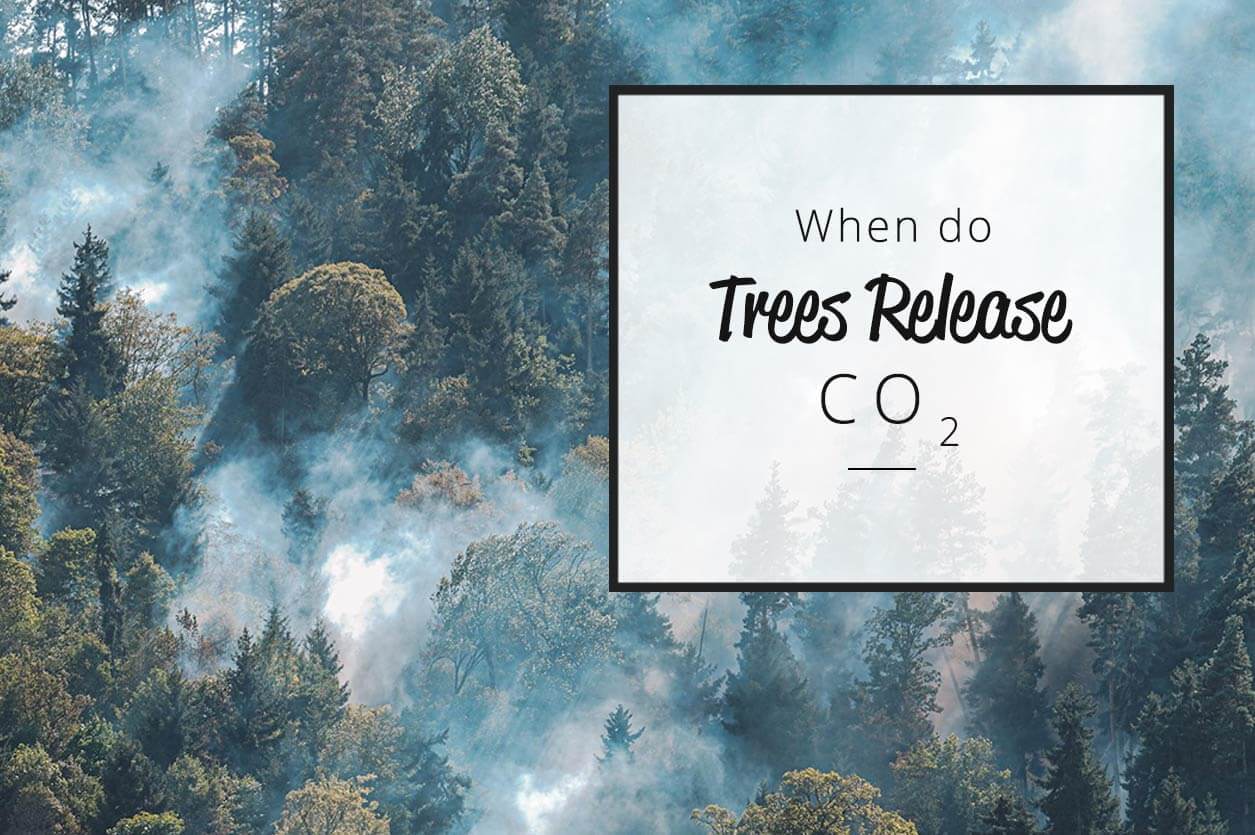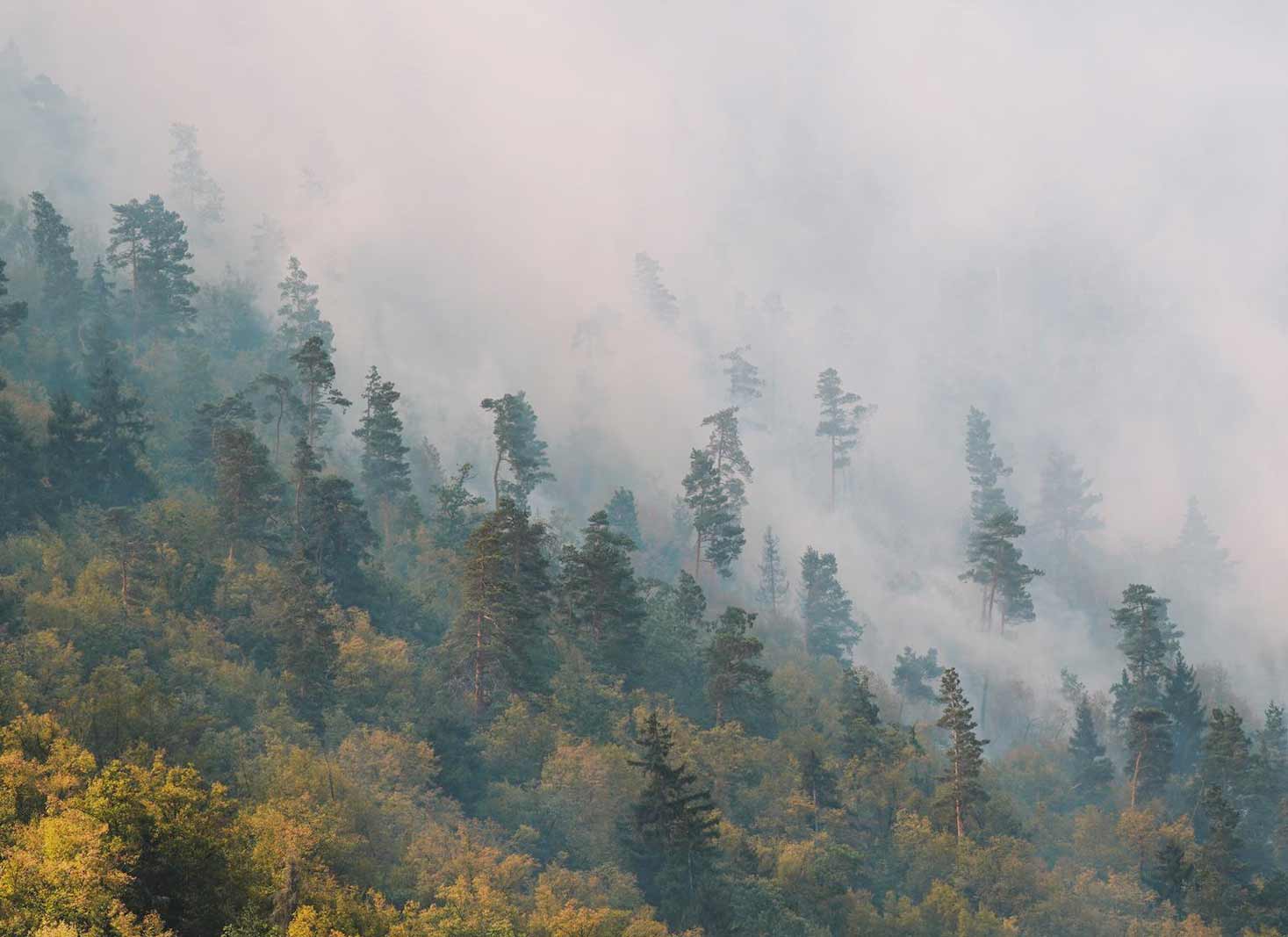It’s commonly understood that trees absorb CO2 and emit oxygen. Yet, it’s less known that trees also emit carbon dioxide (CO2) during periods when they are not undergoing photosynthesis.
When humans breathe in the air with a 20:80 mix of oxygen and nitrogen, we only absorb about half the oxygen and breathe the rest out. Trees are similar, as they absorb CO2 through photosynthesis during the day and then release about half of that absorbed CO2 at night during respiration.
Trees take in CO2 during the day to make food through photosynthesis and release oxygen as a by-product. Photosynthesis does not occur at night, so the trees take in oxygen and release CO2.

What we cover
ToggleHow do trees release CO2?
During the night, the CO2 released by the plants and trees goes directly into the atmosphere since there is no photosynthesis. The carbon stored will not be processed as there is no sunlight, so it is discarded because it could do more harm than good to plants.
The respiration1 of plants at night emits more carbon dioxide into the air than during the day.
Aside from this natural carbon cycle, a man-made practice called deforestation also releases into the atmosphere the stored carbon in trees as they are cut, burned, or left to rot.
Is it vital that trees release carbon dioxide?
What’s with trees and CO2?
Trees are considered the lungs of the world. Perhaps you are already familiar with how they work as Earth’s vital aid to life and the atmosphere. A tree releases oxygen for humans and animals to breathe. It not only gives shelter and food but also helps the ecosystem maintain its equilibrium.
Carbon dioxide, on the other hand, is vital to plants and trees. It is nourishment for them. Using sunlight as a support, CO2 is absorbed by trees along with water to form oxygen and to create sugar as food, as in photosynthesis. Without carbon dioxide, trees will not survive.
How do trees absorb CO2?
It’s not as if a tree would only lift its leafy arms and catch carbon at any time of the day. What it needs is the sun for support. The leaves of a tree capture carbon dioxide when the sun is up and store it in the trunk and the roots. The amount of Co2 absorbed depends on the type of tree and its growth rate.
And what happens to the CO2 that is stored?
In this part, the sun is of great help! The sun’s energy forms a chemical reaction with the carbon dioxide and water molecules and processes them to become glucose (sugar) and oxygen. The sugar then becomes energy through mitochondria and aids in the growth and repair of plants. The oxygen is released into the air and serves the other organisms and humans for survival.
The absorption of carbon dioxide also significantly helps the environment. As CO2 is pulled in, trees release oxygen into the environment. It is always a cycle. It is like a reciprocal function of taking and giving in return. A good amount of oxygen is given as carbon dioxide is received, which is important for most living organisms to survive and maintain the balance of the Earth’s ecosystem.
CO2 released through respiration and deforestation
1. Respiration
With respiration, a tree breathes out CO2 when there is no photosynthesis. However, trees also respire during the daytime. Only a little carbon is emitted into the environment because it is used again for photosynthesis.
The only difference between releasing carbon dioxide during the day and at night is the percentage of emissions.
When a tree performs photosynthesis in daylight, it absorbs a greater amount of CO2 than in the nighttime because sunlight helps pull in carbon dioxide like a magnet.
The amount of carbon that is captured exceeds that which is emitted. It is during the night that trees “exhale” more CO2 because sunlight is not present to aid with carbon absorption for use in photosynthesis. But they still need to breathe, so they inhale oxygen instead of carbon dioxide.
Respiration continues even without photosynthesis, and because there is no use for CO2 at night, it is vented out and oxygen is used by the plants and trees to survive. When temperatures also increase, plants release more carbon dioxide because they try to breathe enough to keep cool.
2. Deforestation
Deforestation is another thing. Carbon dioxide is released when forest trees are cut, burned, or even left to rot. Although there are many reasons why trees and plants die, which causes the emission of CO2 into the atmosphere, deforestation2 and forest degradation are the most common destructive forces on tree populations.
Why is carbon released when trees are destroyed?
When trees die, their natural functions cease to perform and their metabolism stops. Hence, the carbon stored for their sustenance is dispersed into the air.
Behind the ability to exhale CO2
Trees, especially those in vast forest lands, play a crucial role in alleviating the devastating impact of climate change. Thanks to their natural ability to absorb carbon dioxide with the sun’s aid and their release of more oxygen to clean and cool the planet.
These woodland timbers contribute to negative emissions. Imagine absorbing the unwanted carbon dioxide in the atmosphere that adds to the Earth’s incessant rise in temperature. What a big help to the environment.
How do human activity impact climate change?
Human activities release over 30 billion tons of CO2 into the atmosphere annually. If half a trillion trees were planted, the world could capture about 205 gigatons3 of carbon, reducing atmospheric carbon by about 25%.
There are over three trillion trees on the planet, and more are being cut down. These trillions can help lower the Earth’s temperature through negative emissions. But if these vast numbers and more are cut or burned, carbon dioxide will be emitted into the atmosphere, contributing to further global warming.
Thanks to land clearing, burning of wood products, and wildfires, forests also emit an estimated 8.1 billion4 tons of gas back into the atmosphere.

Are trees climate villains for emitting more CO2?
There are now questions about whether people should still plant more trees. For other authorities, it could cause more peril than protection. Climate change is faster than growing trees.
Because of timber harvesting, forest fires, or other strategies that destroy woodland plants and trees, a forest can become a source of carbon rather than a store or sink when trees die and emit carbon into the atmosphere. Without carbon dioxide, the Earth would possibly suffer from the inhospitable cold.
But too much of it also makes our planet hot. Our trees do help in keeping the environment cool and clean by giving oxygen. But because of forest degradation that causes the release of carbon dioxide into the air that contributes to global warming, the vital role of trees is now negated.
Though, in the study5, Nature Communications, the co-author Brent Sohngen stated, “While we’re putting billions of tons of carbon dioxide into the atmosphere, we’re actually taking much of it out just by letting our forests grow. We should be planting more trees and preserving older ones because at the end of the day, they’re probably our best bet for mitigating climate change.”
CO2 emissions from trees—continued cycle
Trees will continue to release carbon dioxide, dead or alive, whether you like it or not. It is their physiological function. It is nature. Amidst the negative effects on the planet because of more CO2 in the atmosphere, trees will permanently hold their value to the environment, such as providing oxygen, food, and shelter.
The presence of trees provides additional direct and indirect benefits to human health and wellness, and their constant venting out of carbon dioxide does not devalue them.
The release of CO2 by trees, whether through respiration, deforestation, or other measures, is natural. Unless there are advanced methods of stopping the carbon emissions caused by humans, the cycle will continue and never end.
- Charlie Outhwaite, (2023) Is it true that plants release CO2 during the night and that I should not have one in my room? <https://www.ucl.ac.uk/culture-online/case-studies/2023/feb/it-true-plants-release-co2-during-night-and-i-should-not-have-one-my-room> Accessed: 16-03-2024.
- Annika Dean, (2019) How does deforestation contribute to climate change? <https://www.climatecouncil.org.au/deforestation/> Accessed: 16-03-2024.
- Alan Buis, (2019) Climate Change: Vital Signs of the Planet. <https://climate.nasa.gov/news/2927/examining-the-viability-of-planting-trees-to-help-mitigate-climate-change/> Accessed: 16-03-2024.
- Nancy Harris and David Gibbs, (2021) Forests Absorb Twice As Much Carbon As They Emit Each Year. <https://www.wri.org/insights/forests-absorb-twice-much-carbon-they-emit-each-year> Accessed: 16-03-2024.
- Tatyana Woodall, (2022) Climate change is turning trees into gluttons. <https://phys.org/news/2022-09-climate-trees-gluttons.html> Accessed: 16-03-2024.



